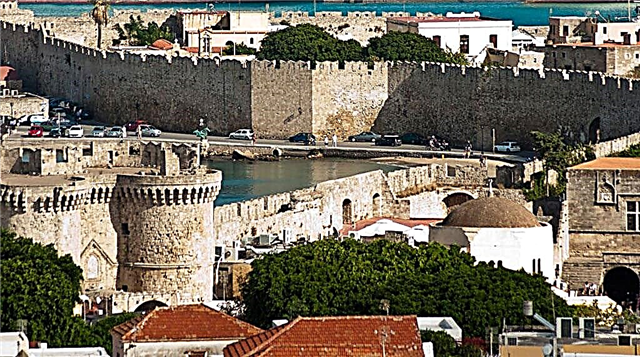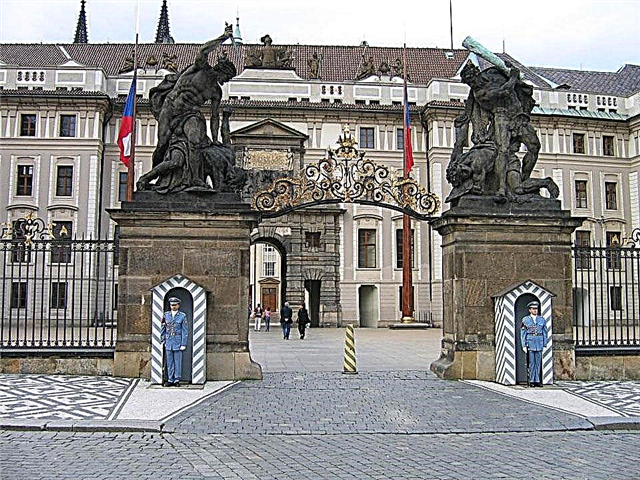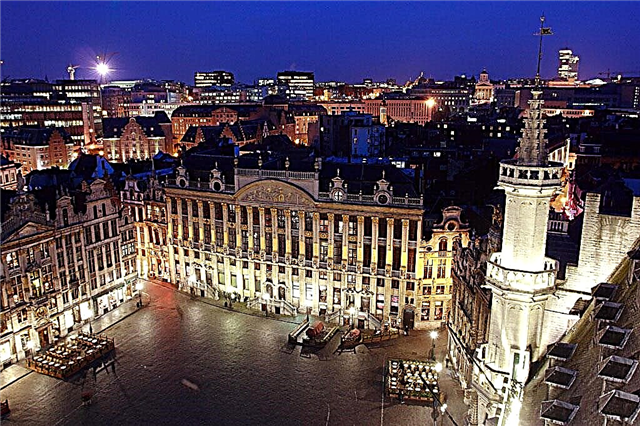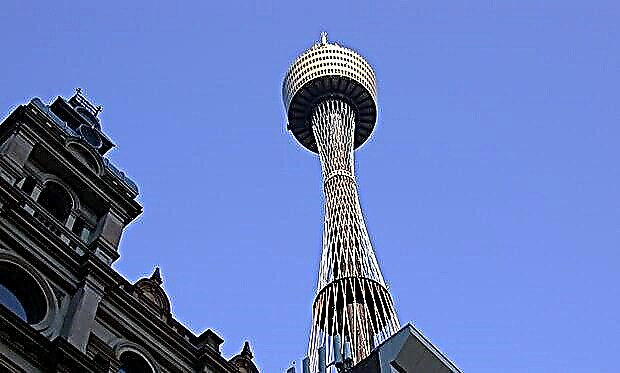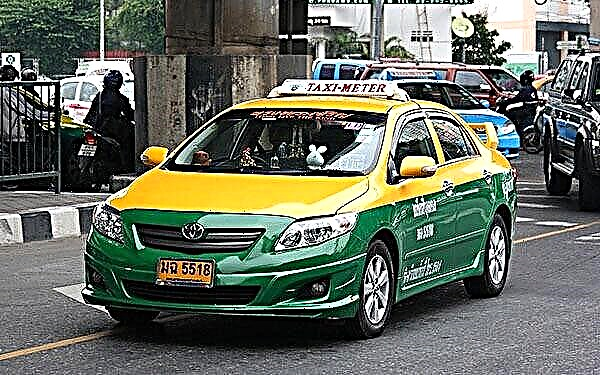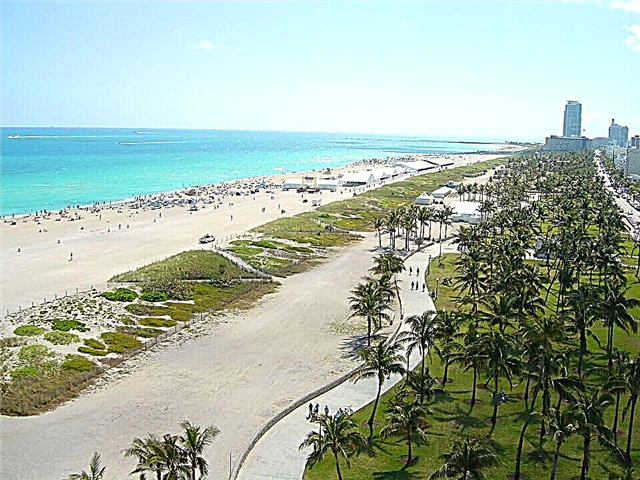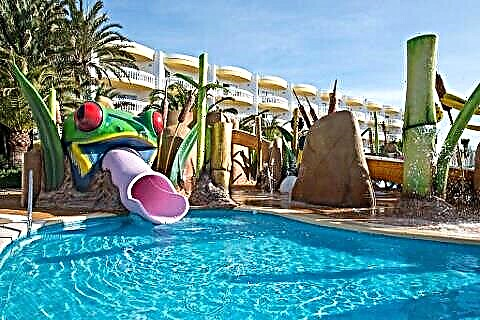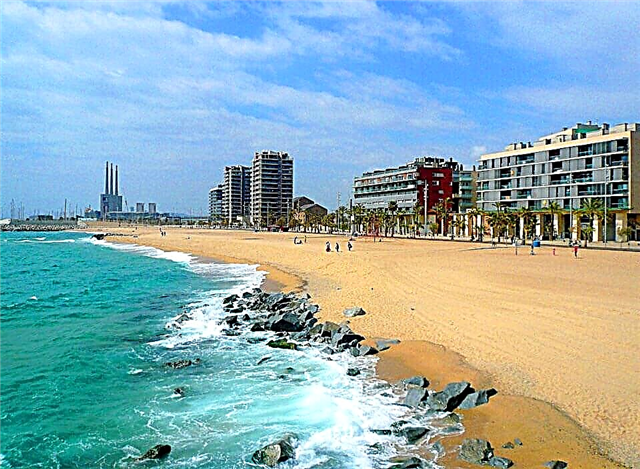Experienced travelers know that true Spain is not so much Barcelona as its surroundings. After visiting the museums of the capital of Catalonia, walking along its streets and examining the chic buildings on them, it's time to explore the nearby locations. Choose according to your taste where to go from Barcelona for 1 day on your own. It can be a mountain village of witches or a soft sandy beach by the azure sea. Visit a secluded monastery or wander through the Spanish quarters, conquer peaks or wander into a sacred cave, bypass museums or stretch out on a lawn in a park ... It is not necessary to adjust your plans, focusing on the transport schedule. Sometimes it is much more convenient to rent a car and plan your route yourself. So what is there, outside of Barcelona.
Girona

Girona is located 100 km to the north-east. The city is divided into two parts by a river. The modern districts of Girona are located on the left bank, the historical treasury on the right. Game of Thrones fans will recognize the medieval streets of Girona as Braavos. The majestic building of the Cathedral stands out against the background of low buildings. It was built from the 11th to the 18th centuries and is an ensemble of architectural styles. There is a museum inside the cathedral.
Arab baths, built on the basis of ancient Roman baths, were built 900 years ago. A picturesque pool with columns around it has survived to this day. The Historical Museum of Girona owns a huge collection - artifacts from different times are presented in 14 exhibition halls. The Museum of Jewish History will give an idea of the life, customs and life of ethnic communities in the period from the 9th to the 15th century. The Art Museum in the Bishop's Palace houses works of art dating back several centuries.
Figueres

The city that Salvador Dali glorified, because it was here that he was born and found eternal peace. Figueres is 117 km away from Barcelona, and you can walk around its center in just 15 minutes. It borders on France and is the wine-making capital of Spain, so lovers of tasting the drink of the gods should definitely include it in the must visit list. The heart of Figueres is the theater-museum of Salvador Dali with a crypt that houses the ashes of an outrageous surrealist. The artist turned the theater building into a kind of installation, so it can be seen from afar.
Both adults and children will be interested in visiting the unique Toy Museum of Catalonia. It has collected 4.5 thousand handicrafts from various materials and served for the entertainment of children and the amusement of adults at different times. The toys of the famous Spaniards are also part of the museum's collection, and rare examples from the past are depicted in old photographs and postcards. St. Peter's Church is a building with a thousand-year history, which is an example of Catalan Gothic. San Ferrand Castle is an 18th century building that has perfectly preserved its original appearance.
Besalu

Besalu is a tiny islet of antiquity in the province of Girona, 1.5 hours drive from Barcelona. About 2.5 thousand people live here today. Against the background of green hills, stone towers and structures rise, the appearance of the city is very memorable and original. The history of Besalu began more than a thousand years ago with the construction of a castle, the ruins of which can be visited during an excursion.
The main attraction of Besalu is the old bridge with seven spans, erected in the 12th century; it is through this bridge that travelers get to the historic center of the town. The atmosphere of the Middle Ages is so strong here that sometimes you forget about what is now ... century. Column buildings, balconies entwined with flowering plants, houses with old facades - the spirit of European antiquity is simply in the air.
The city has a "Museum of Microminiatures", divided into three parts. The first presents exhibits that can be viewed with the naked eye, the second - those that can be seen with a magnifying glass, and the third - a collection that is visible only under a microscope. St. Peter's Church, St. Julian's Hospital, an old mill, a watchtower, Carnell's house, the main square - Besalu have something to captivate tourists.
Rupit

You can get to the mysterious ancient city of witches only by car, the distance from the capital of Catalonia is just over 100 km. In the mountains, in the middle of the forests, an inhabited area appeared in the XII century, and although it was cut off from civilization by an impregnable gorge, the first settlers felt here under the protection of nature itself. The place nestled on the tops of the cliffs is so inaccessible that even Napoleon gave up the idea of conquering it.
The remoteness from the cities also protected the inhabitants during the period when the plague struck Europe. According to legend, in the Middle Ages, half of the population were witches, so the God-fearing aborigines called inquisitors to Rupit. Supposed witches have fallen out of favor, as have stubborn Jews who refuse to convert to Catholicism, and any townspeople suspected of heresy. Until now, walking along the narrow stone streets of the city, tourists feel a certain tension and heavy energy that remained in Rupite from those terrible times.
Modern Rupit is divided into two parts. On one side of the river its historical part, on the other - quite inhabited. The city is home to about 400 people, and even has a school, kindergarten, markets, a church and a court, not to mention such a good of civilization as electricity. Be sure to visit the picturesque mystical town that combines the Middle Ages and modernity, reality and legends.
Castellfollit de la Roca

About two hours on the way and you are in a tiny town on a cliff with a complex name Castellfolit de la Roca. The first mentions of it appear in the XII century, when the Spanish barons chose the rocky language for the construction of family estates on it, surrounded for safety by a fortress wall. Erected on top of a cliff, it began to collapse after earthquakes in the 15th century.
By the way, this area is seismically unstable, because there are still about 70 active volcanoes in the Garrotxa volcanic region, which includes Castellfollit da la Roca. But this does not prevent the town from existing today: its population is about 1000 people. But due to the lack of slender rows of tourists here, the place looks secluded and half-abandoned.
According to National Geographic, Castellfollit de da Roca is one of the top ten settlements with the most beautiful views, so it is definitely worth paying attention to. When you decide to take a day out on a self-drive tour from Barcelona, grab a blanket and a full picnic basket for when else you can relax outdoors with views of Spanish landscapes and remains of medieval architecture.
Vic

It will take a little over an hour by car to get to ancient Vic, a city with a rich and long history. That is why the originality of the city is of interest to its guests: here are collected and organically intertwined the features of several European cultures at once, which at different times influenced the appearance of the settlement. On the streets there are modernist baroque houses, buildings of the Renaissance, and all this does not look ridiculous or tasteless.
On the contrary, architecture has the balance and charm of the Spanish province. The best days to visit Vic are Tuesday and Saturday. Stalls and stalls are stretched out in the main square twice a week, opening the local fair. Everything made by farmers, gardeners, craftsmen and needlewomen is sold here, from honey to embroidered table linen.The main attractions of Vic are the Episcopal Museum, Plaza Mayor, and a 1000-year-old Romanesque tower.
If you are lucky enough to get here in December, do not miss the annual festival: a medieval market opens, costumed performances are staged, guests of the city are entertained with all kinds of numbers.
Monastery of Montserrat

The road from Barcelona to the pilgrimage center of Catalonia - Montserrat Monastery - takes no more than an hour by car. You can also get here by bus that runs here, but be careful, only once a day. Those who like to take a nap to the rhythmic sound of the train wheels will also be pleased: you can also get there by rail.
Montserrat Monastery is a three-in-one for travelers. Firstly, it is a skete with a thousand-year history, in which about a hundred monks still live. In addition, the monastery has an interesting cultural and historical museum, which contains 6 different collections. Moreover, these are not only icon-painting exhibits, but also a selection of ancient paintings by artists (from the 13th to the 18th centuries) and even a collection of jewelry made of gold and silver.
The Holy Cave is a place for which many believers make a pilgrimage to Catalonia. According to legend, the image of the Mother of God appeared in it at the end of the 9th century. Mount Montserrat is a familiar place for climbers. This jagged giant is regularly climbed by climbers from all over Europe. There are many hiking trails of various difficulty levels in the Montserrat Nature Reserve. Walking through the natural attractions, you will be enchanted by the rich flora of the area and you can see representatives of the fauna.
Badalona

The ancient coastal town is considered by many to be the outskirts of Barcelona, because the distance between them is only 10 km. Badalona's business card is a six-kilometer sandy beach along which low houses are lined up on the shore. Even before our era, the ancient Romans settled in the vicinity of the town, and the locals are still proud of the Italian roots and relics that they carefully preserve. The city museum displays ancient Roman baths, water pipes, an ancient aboriginal dwelling and wall paintings.
Among the palm trees and various exotic plants, you can stroll in the Turo del Caritg park, which is equally beautiful in the daytime in the sunlight, and in the evening, illuminated by many lanterns. Badalona is a hospitable Spanish “hostess”; various festivals are held here. For example, the Teatro Sorrilla hosts an annual screening of short films. But the authorities of Badalona are planning to further develop its cultural appearance, and soon the "City of Music" will open, where you can listen to classical music.
Mataro

Mediterranean town stretches along the coast. The distance from the capital of Catalonia is 30 km, so many tourists leave the bustling city for the neighboring quiet sandy resort. Beach lovers in Mataro are ten times less than in Barcelona.
The beaches are artificial, but incredibly clean and well-groomed, equipped with everything you need for a comfortable stay. Except, perhaps, the changing rooms we are accustomed to. The historical and cultural attractions of Mataro are located away from the coastline on the mountain. The city museum has occupied a building to match it: the structure of the 16th century contains all the exhibits and artifacts, most of which are archaeological finds.
Another architectural monument is the Basilica of St. Mary. The temple was built in the neoclassical style, and its interior is characterized by baroque elegance. On one of the streets of Mataro, part of the fortress wall, built in the 16th century, has been preserved. There are many architectural masterpieces in Mataro. Seeing them, you cannot take your eyes off these ornate patterns on the buildings and try to decipher the author's mysterious idea. Among these buildings is the House of Coll and Regas or the House of Perera.
Sitges

A resort is located on the Cote d'Azur, which in the recent past was an ordinary fishing village. Sitges is a town where the weather is always good, because there are at least three hundred sunny days a year. The famous San Sebastian Beach has been voted the best beach in Europe by the New York Times. Therefore, wealthy Americans and Europeans chose Sitges for permanent residence, which led to a huge increase in house prices.
As a result, the young residents of Sitges were forced to leave their homeland, as the cost per square meter became sky-high. All year round, Sitges is a constant cradle of all kinds of parades, festivals and carnivals. Guests are entertained with all kinds of events from gay pride parades to harvest celebrations, and there are always bright and memorable performances. The abundance of nightclubs and bars along the coast gives the impression that Sitges never sleeps at all.
But, as they say, not a single amusement ... And in the city there are places where you can taste spiritual food with a full "spoon". For example, walk through quiet streets or retire on a picturesque Moroccan-style veranda. Museums, galleries, chapel, churches, palace - these and other locations will pleasantly surprise tourists who considered Sitges to be nothing more than a frivolous resort town.
Lloret de Mar

The main Mediterranean resort of the Costa Brava welcomes many guests at any time of the year. The hot months from May to October are the time of youth. Discos, clubs, open-air bars, incessant music, many DJs and entertainment at night - this is Lloret de Mar in high season. Calm measured pastime of older guests falls on the remaining six months - from November to April. The mild subtropical climate of the resort makes it attractive in cold weather.
Here curious tourists will find everything from an open-air necropolis museum to a large noisy water park. At the same time, the modernist cemetery is far from a gloomy, frightening landmark, but a curious place full of burial culture. Very interesting from the point of view of the national flavor and architectural appearance of the city. The three-storey young (2002) Museum "Cat's House", based on a private collection of our compatriots, will curiously tell about the historically established relationship between a person and a domesticated pet.
Everything related to the "cat" theme - drawings, jewelry, household items, sculptures, stylized figures made of crystal, wood, clay - is presented in six halls of the museum. In Lloret de Mar you will have a different, but always interesting time, whether it is a water park, a gnome park (a curious place), a church, a chapel, a castle or the gardens of Santa Clotilde.
Cardona

The imposing castle and town of the same name in Catalonia was the abode of several civilizations, which, one after another, were mercilessly swept away by time. Today Cardona is a village 80 km from Barcelona. It is known to the world for its castle, in which mysterious mystical events still take place. A long time ago, the castle was built on the mountain to ensure the safety of the area and to inform in advance about the impending raids of Muslims.
Currently, it has been completely renovated and converted into a hotel. In which there is the very chilling number 712. According to eyewitnesses and impressionable travelers, a ghost in monastic attire walks along the corridors of the castle-hotel, objects move by themselves, and terrible sounds frighten even the most skeptical guests. Mysterious room 712 is not rented out in the general order, it is settled there only in case of an individual request. Whether the tourists come out of it gray-haired the next morning is unknown.
Aigwafreda

A little more than 40 km and you are in a medieval mountain village, the path to which runs through a picturesque serpentine and forest paths.This hiking route does not require much physical training, but if you rate your endurance in hiking as a "minus three", consider whether the walk is within reach. The old village houses that you meet at the beginning of the journey seem like fairytale huts from fairy tales, modestly nestled on the edge of a mountain ridge. Another relic is the old mill, which is impressive for its size.
Along the way, there are nests of alpine predators - griffon vultures; they often hover right above the paths laid by local residents and tourist groups. This holiday destination is perfect for creative natures who are looking for inspiration while traveling: the local landscapes are so colorful that even the most protracted creative crisis will come to naught. Couples or families in love, having taken what they need for a picnic, will find peace here, they will be able to communicate in an atmosphere of unity with nature. And athletes will have the opportunity to test their strength, daring to conquer the nearest peak (1100 m above sea level).
Tarragona

The port city in the south of Catalonia combines everything: beach holidays, historic buildings, architectural highlights and colorful national holidays. The huge Gothic windows of the Cathedral of Tarragona are visible from afar, and it is not surprising: it is the largest Catholic church in Catalonia. The construction of the majestic structure began in the XII century, lasted about two hundred years and showed the world the main symbol of Christianity in all its glory.
Since bullfighting has been banned in Catalonia, the Tarraco Plaza arena with a capacity of 17,000 spectators has been hosting concerts, festivals, performances, sports competitions and all kinds of performances on various topics. "Cherry on the cake" when visiting Tarragona - climbing the Mediterranean balcony. From there you can enjoy exceptional sea views and a breathtaking panorama of the coastline. Local belief says that by rubbing the cast-iron fence of the balcony, travelers will forever gain good luck, which will accompany them in all their endeavors.
Do not forget to visit the Central Market of Tarragona - a monumental structure that looks more like a train station or a museum: its arched facades look the same on all four sides. The shocking monument of Caateleros features 259 full-length human figures who have built an acrobatic pyramid. It is better to see these and other special places of Tarragona once than hear about them a hundred times.
Vilanova i la Geltru

The pearl of the Mediterranean coast is hidden 40 kilometers from the capital of Catalonia. The resort, famous for its golden sandy beaches, was founded in the 13th century, so it has something to show from its history. In addition, Vilanova has an excellently developed tourist infrastructure: an abundance of restaurants and cafes, comfortable beach areas and hotels for every taste and budget can tempt you to stay here for a couple of days.
Visiting the Railway Museum, tourists combine business with pleasure: here you can learn interesting facts from the history of railway transport and see real electric trains, carriages and steam locomotives, both outside and inside. In the museum of romance, tourists will find the setting of the 17th-17th centuries: graceful curtains, decorative stucco moldings with gilding, ornate patterns on furniture, a kitchen and a pantry of the past - visiting this place, you can go back in time without a time machine. Walking along the central Rambla, the city beach, the medieval Blue Tower, the Art Museum - leisure in Wilanow can be varied and exciting.
Manresa

A high-altitude historical oasis in the center of Catalonia, 55 km from Barcelona, is famous for its monumental buildings, hills and shrines. The famous 13th century bridge across the Cardener River is Mansera's architectural landmark. The majestic Basilica of Santa Maria de la Seu is another cultural landmark of Mansera. It was built in the 14th century in the Gothic style, after which it was rebuilt and restored many times. The surviving look of the temple was given to it by architects in the 19th century. Fun fact: the Basilica in Manser is very reminiscent of Barcelona's Santa Maria del Mar.
And all because these churches were built according to the project of the same architect. The shrine of Mansera is the Santa Cova Cave, where pilgrims from all over Europe flock. There is also a church and a souvenir shop attached to it, where you can buy something as a gift or for yourself as a keepsake of visiting this holy, peaceful place. The city bridge also looks impressive, and the historical buildings that make up the wonderful architectural ensemble of Mansera are perfectly visible from the Saint-Domenech square in the city center.
Valencia

Valencia is famous for its historic buildings and modern impressive buildings, lush green parks and mild climate. Its main attractions are concentrated in the historical center of the city. The futuristic building of the City of Arts and Sciences has become a symbol of Valencia today. This cultural and entertainment complex contains: an IMAX cinema, a theater, an oceanarium, a planetarium, a botanical garden and a science museum. You can taste the Spanish flavor by visiting Valencia's Central Market, open from Monday to Saturday.
The huge covered building consists of two pavilions and resembles a lively oriental bazaar. Why not take a look at wild African animals in their natural habitat? Valencia Biopark is divided into 4 zones: Madagascar, dry savannah, humid savannah and African equatorial forests. The huge area of the zoo is inhabited by 116 species of animals, and the individuals themselves are no less than 8000. It is difficult to spend just one day in Valencia, because you need to have time to see the city squares, the picturesque area of El Carmen, cathedrals, the bullring and other interesting locations.
Salou

One of the main Catalan resorts has grown from a fishing village into a popular destination for beach lovers over the decades. Salou is famous for its incomparable fountain show, which captivates tourists who come out on the evening promenade. Dozens of water jets of different colors soar into the night sky to the accompaniment of music. The famous Aventura amusement park is also located here.
Even the most serious adults here become cheerful children, because it is impossible to remain calm and contain enthusiasm at the sight of the high loops of the roller coaster. It organizes a large-scale animation program and boating on mountain rivers. In the city park, decorative bridges stretch across artificial ponds with water lilies, and paths are laid through dense thickets of lush Mediterranean vegetation.
A large park was created so that in the middle of the pristine beauty of nature, residents and guests of Salou could take a break from the hustle and bustle of the city. The boulevard of King Jaime I along the coastline, the church of Santa Maria del Mar, the Catalan manor are attractions that are also noteworthy.
Zaragoza

The identity of the province and the grandeur of the metropolitan areas unite Zaragoza, located between Barcelona and Madrid. The ancient city is a treasure trove of attractions that can win the hearts of even the most sophisticated travelers. A unique place of its kind - the natural park of the Monastery de Piedra. Although it is located 120 km from the city, it is worth a visit. The monastery was founded in the XII century in the middle of a beautiful nature reserve. Ancient architecture is mesmerizing: mossy stone vaults and arches rise mysteriously amidst green landscapes.
Waterfalls around (the highest - 50 m) create a fabulous unique atmosphere. Calle Alfonso's pedestrian street is lined with graceful buildings on both sides. In the famous Pilar Square, the architects have erected a futuristic fountain in the stone jungle. The Ispanidad Fountain is a map of Latin America and flows into a basin in the form of South America.In Zaragoza, the ancient Roman theater, several stunning cathedrals, the magnificent Aljafería Palace, museums, a stone bridge of the early Middle Ages and many other notable places have been preserved.
Andorra

The distance between the tiny European state and Barcelona is 223 km. Lovers of skiing from all over Europe flock to the Principality of Andorra every year. Station Grandvalira is a place of pilgrimage for skiers, as there are more than 200 ski kilometers. The station has three snow parks and many slopes of different difficulty levels and is recognized as one of the best ski resorts in Europe. Surprisingly, another trademark of Andorra is shopping.
The state has abolished VAT, so shopaholics tend to come here for bargain purchases. The highland principality, of course, also has a capital - Andorra la Vella, which is very reminiscent of a classic European city, only on a small scale. Cobbled streets, low-rise colorful houses, friendly locals and many restaurants serving ethnic cuisine similar to Spanish.

